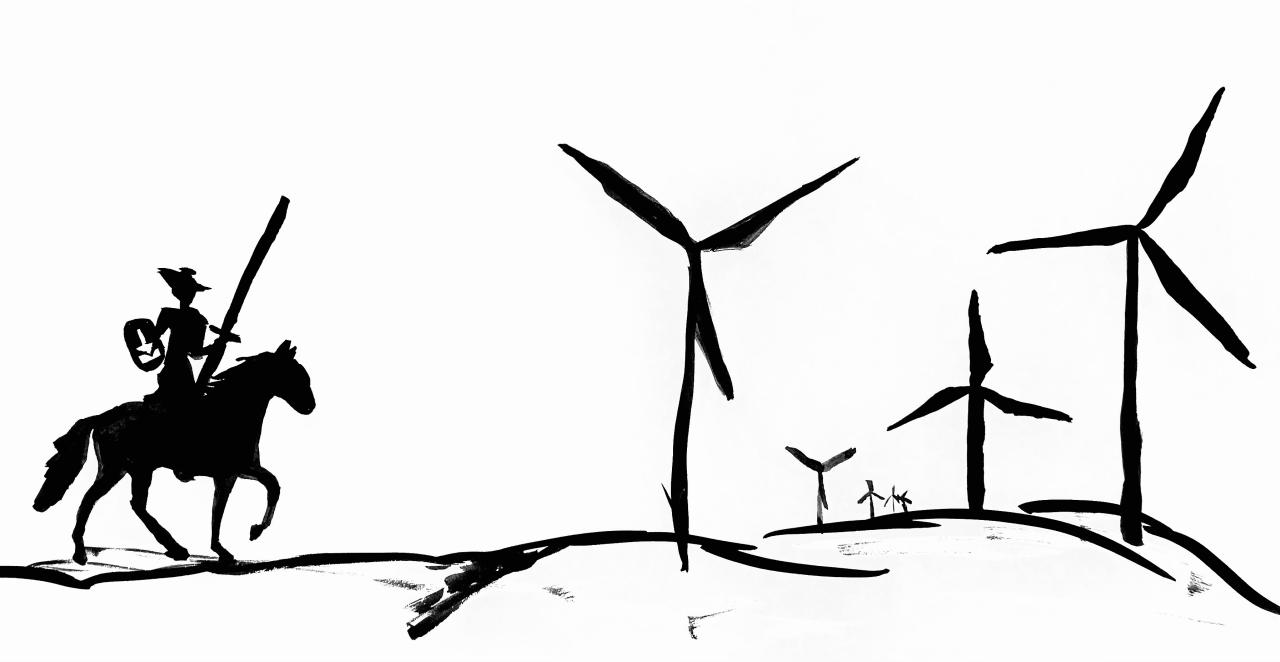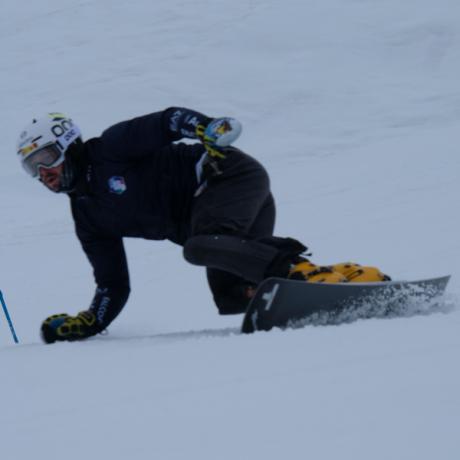Although a C-Sink snowboard contains only a few grams of biochar carbon, it clearly makes a difference. Extremely fine milled high-temperature biochar is injected into the prepreg ("pre-impregnated") carbon- and glass-fibers used to build snowboards, skis, or bicycles. It improves the snowboard's ability to absorb energy during hard carving turns, which is then released when rebounding at the end of the turn, allowing acceleration between slalom turns. The addition of NanoC reduces the vibration (= energy loss to heat) of the board and improves the ability of the board to store energy when the board bends and provides more acceleration when the board-bending is released. The nano-sized biochar particles act, thus, as a battery or rather capacitor within the composite material, capturing and returning the energy according to the bending stage of the material.
The biochar makes the snowboard faster by minimizing energy loss in each turn. It reduces vibration, ensures smoother rides, diminishes electrostatic charging, and contributes to a noticeably livelier board feeling.
Even amateur riders can clearly feel the difference, enjoying a more powerful, cutting-edge, and smoother ride. Professional athletes measure the advantage on the racecourse. When seven of the top ten snowboarders in the world choose biochar-enhanced snowboards, the performance benefit cannot be mere imagination. The mixed-team World Champions, Elisa Caffont and Maurizio Bormolini, were notably the only team using biochar in both snowboards, highlighting that the material advantage was undoubtedly part of the success story (see: www.c-sinksports.net). In boardercross, another snowboard discipline, biochar-containing C-Sink boards secured already for the second time the women's overall World Cup and this year's mixed-team World Championship titles.

Figure 1: Maurizio Bormolini wins the alpine snowboard overall World Cup 2024/25, advancing Andreas Prommegger and Daniele Bagozza. All riding with Global C-Sink snowboards containing biochar. © Miha Matavz/FIS
In elite sports, where fractions of a second can make the difference, even small material advantages can be decisive. Ski and snowboard brands invest heavily every year to provide their athletes with the most advanced gear possible. Typically, differences between top brands are minimal, and improvements are incremental. It's only once in a decade that a brand comes up with an invention that gives their athletes a clear edge—biochar is proving to be one of these rare breakthroughs.
How does biochar affect composite material's function?
Biochar impacts the material properties of the composite material of the snowboard in a multifaceted way. Some effects can be easily understood with traditional physics we learned at school. One of these effects is the reduction of electrostatic charging due to the friction of the snowboard with the more or less dry snow due to the electric conductivity and electron buffering of the biochar. Other effects need quantum physics for their explanation, and here, we are probably not the best to explain it comprehensively. We will, however, try it.
The electron cloud of biochar's aromatic clusters is capable of capturing phonons that are transmitted in a solid material when it is put under mechanical stress. Typically, vibrations in skis or snowboards produce phonons that mostly dissipate as heat, resulting in energy loss and, therefore, reduced speed potential. However, when the aromatic biochar lattice captures and accumulates those phonons, the energy can be reinjected into the materials as soon as the material tension releases, for instance, at the end of a turn.
The aromatic carbon clusters of high-temperature biochar possess extremely low electrical resistance, and their electron clouds, containing persistent free radicals, can readily capture and release phonon energy. Phonons are quantum particles analogous to photons, but not as quantized light but as quantized sound waves propagating through materials. Phonons can be described as quantized modes of vibrations in elastic structures of interacting particles. In NanoC materials, they interact with the diverse aromatic structures such as graphene, fullerenes, and carbon nanotubes that are found in high-temperature biochar.
Additionally, wave-like excitation of the electron clouds of the aromatic structure of biochar can be set up by targeted electromagnetic waves. These frequencies are then stored within the NanoC particles and can induce resonance in specific components of snowboard materials, effectively mitigating unwanted oscillations under mechanical stress.

Figure 2: Elisa Caffont and Maurizio Bormolini are the 2025 World Champions. © Miha Matavz/FIS
Well, we still keep some little secrets in the production procedures to maintain the competitive advantage for our C-Sink athletes. After three years of research, development and testing there is, no doubt, much more to it than simply mixing any kind of biochar into resin. However, the decisive message remains clear: Organic carbon extracted from the atmosphere, assimilated by plants, and transformed in renewable energy facilities delivers tangible technological advantages in high-end materials. Moreover, the EBC-certified biochar in materials with an average lifecycle of more than a year constitutes a Material C-Sink. It can be certified and registered as a temporary C-sink to temporarily offset the climate-warming effect of greenhouse gas emissions.
Sports gear is just the beginning. Under the name of C-Thinx, as we call the NanoC containing C-Sink materials, we work on reducing vibrations of wind turbine rotor blades and, thus, increasing their energy efficiency. It will further be employed in carbon concrete, extending the lifespan of constructions such as bridges and tunnels. When integrated into asphalt for roads, it will significantly reduce tire vibration, thereby lowering noise pollution, fuel consumption, and gum abrasion while increasing the longevity of the asphalt. There are many more advanced biocarbon materials on the list, poised to replace conventional petrochemical products.

Figure 3: Knights of eternal persistence fighting temporary C-sink mills
Professional sports showcase the potential of planetary carbon recycling. Winning World Cup races with biochar-based materials, C-Thinx prove the superiority of advanced pyrogenic carbon for designing natural carbon-based products with added functions. Carbon in the atmosphere is not only a burden but a resource (see Planetary Carbon Recycling). Let's be smart enough to take carbon for industrial production from the atmosphere and not from below ground. Atmospheric carbon can be turned into high-performance materials that win races, increase productivity, and store it temporarily, which is the true gamechanger of the global carbon economy. Today, biochar is in snowboards, bicycles, and race cars; tomorrow, it will be in roads, skyscrapers, rockets, and humanoid robots.
Disclaimer 1
All C-Sink Snowboards are built by Oxess in Switzerland. Oxess is one of the most successful alpine snowboard brands. Nevin Galmarini won his Olympic title on an Oxess board, and there were other World Cup victories before the collaboration with Ithaka. However, the 2024/25 season, with seven riders in the world's top ten and overall titles in Alpine Slalom and Boardercross, was the most successful season in Oxess' 30-year history. We are grateful to Marcel Brunner for the opportunity to collaborate over the past three years in material and snowboard development.
All snowboards that are built with the NanoC technology carry the Global C-Sink logo and are sponsored by Carbon Standards International.
Disclaimer 2: The 55 Uses
In December 2012, Ithaka published the famous article 55 Uses of Biochar. It was the time before the Kon-Tiki spread artisanal biochar making globally, before the first biochar was certified under the EBC, and nearly a decade before the first C-Sink certifications appeared. In the first paragraph of the article, we stated:
Biochar is much too valuable and expensive for any farmer to be able to afford to spread 10 tons or more per hectare on his fields. Whereas a hectare will normally provide an annual benefit of EUR 1000, the EUR 8000 needed to purchase and spread the biochar would need to be amortised over several decades. The CO2 certificates favored by so many outside the trade would be of no much help either.
We then concluded with the question:
Does it really make sense to work biochar into fields?
Today, 13 years later, the question remains unresolved but is certainly more nuanced. Biochar combined with organics and applied to the root zone of garden crops has repeatedly demonstrated how beneficial it is. Conversely, biochar used in industrial agriculture with optimized crop management schemes on fertile soil cannot further improve yields and typically does not justify the investment even when considering C-sink credits. Biochar made on-farm from farm residues, however, has been shown many times over to enhance farm resilience and autonomy.
However, on-farm and artisanal applications alone cannot achieve a significant climate-saving impact. More markets that can absorb vast amounts of biochar are needed in the next few years to start establishing the Global C-Sink at climate-relevant scales. We, therefore, scroll down the initial article from 2012 and find under #31 the use in carbon fibers and #32 thermoplastic materials. Thirteen years later, while most of the original 55 uses have not yet become mainstream, many have already proven successful. We will revisit the 55 Uses of Biochar in an upcoming article and likely add some more promising applications to reach 99.


Leading understanding and practice…
Thanks Hans-Peter for again helping us to enter the next stages of the carbon age we live in! Best wishes Peter